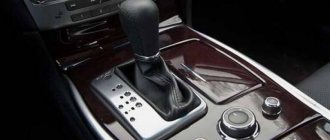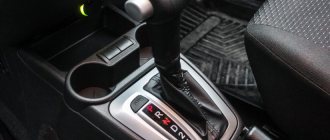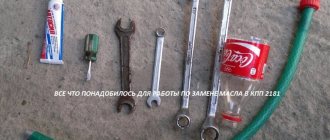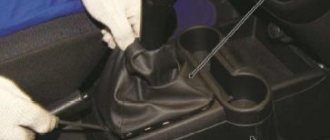Hi guys! The post was created to eliminate educational awareness regarding the robot on Grant, since many are hesitant in choosing this, sometimes strange, unit. Thoughts are purely my own and may differ significantly from other opinions. Who is the robot suitable for?
- for those who want to ride with a stick, but don’t want to work with the clutch and want more comfort in traffic jams.
For those who wanted an automatic, so that everything would be smooth and not think about changing speed at all, this is not a very good choice. Even completely unsuccessful. For this there is another reputable box - Jatco. Is the robot smart with switches?
- yes, this happens when a certain borderline situation is created.
For example, you are rolling into second with the gas released and there comes a moment when the revolutions drop to 650 and the robot is about to switch to first, and you just need to give the gas a sharp boost. And you are ready to accelerate right now. In this case, the robot will switch to the first and will not pull to the second. And switching takes a little time, though. To be fair, I note that my previous Granta also had a 127 engine, but it couldn’t immediately go from idle to second and pick up speed and revs; it became dull (too little torque at these speeds). How fast does the robot change gears?
- not instantly, but not longer than I switched on the handle.
The robot tries to make switching as comfortable as possible. In manual mode it shifts a little faster. Can you feel the gear changes?
How does it feel? - yes, gear changes are mainly noticeable during shifts 1-2 and 2-3.
But here a lot of factors are mixed up (as with manual shifts) - at what speed the shift will be, how the driver pressed the gas before switching - at the moment of switching - after switching. If you drive simply by pressing the gas, as on a classic automatic transmission, the robot will shift with some slowdown in the movement of the car at the moment of switching, since it itself equalizes the engine speed so that the switching is soft (the driver presses the gas and does not think to let go, and when changing speed the engine briefly disconnects from the transmission and the revs would jump). This is the most inappropriate way for this amt.
Below I will write my algorithm, if anyone is interested.
What driving style is the AMT designed for?
- style of a summer resident-retirement.
You will almost always see 5th gear on the display. It is this factor that gives the car a feeling of slowness.
What’s good is that gas consumption is lower than with a stick.
What’s bad is that you have no mobility, you can’t fry until you switch to a lower gear, pressing half the gas pedal to go down one gear or “slipper to the floor” to throw a couple of gears down. How can you get out of the pensioner’s rhythm? 1. Select manual mode and water as if using a handle. 2. Accelerate dynamically and the robot will not let you down, it will play along with you. 3. Flash the box with firmware with a more dynamic algorithm. Where can I get such a plug? Right, and I don't know. What is a “slipper on the floor” on a robot?
— you’re driving 100 along the highway in fifth place, of course, and you need to overtake a Kamaz 05 region with a bow on its way to Moscow.
Overtake quickly. Here is a slipper to the floor! The robot will instantly plug in the third one and the machine will crash like crazy! It will turn the hell out, and then it will only stick in 4th.)) You can do without straining at near maximum speed. To do this, after a dynamic overtaking, release the gas almost completely; the robot will begin to move up to fifth, realizing that the maneuver has been completed. Is manual mode convenient?
— manual mode is cool.
This is the same handle, only without the clutch pedal. Almost the same... Differences - in manual mode you can switch both up and down. If you slow down but don’t shift down, the robot will have to shift down for you. Otherwise, the engine will start to jerk due to the discrepancy between the speed of the car and the selected gear. Thus, you can drive manually and only shift up. The robot will switch down itself. Although I like to turn on the lower ones myself - this way you are in complete control of the situation. By the way, when you shift down, it’s absolutely imperceptible; this doesn’t even always happen with a manual transmission. What is AMT adaptation for the driver?
- oh, guys, I don’t know. But I know one thing - the robot monitors a colossal bunch of processes. And if you, for example, start to accelerate dynamically and press the gas on the first one, then at about 30 mph let off the gas a little, the second one will turn on and again press the gas, accelerate to 70 mph and let off the gas a little - on. 3rd and again gas... the robot will shift exactly the way you want - the acceleration will be dynamic and the AMT will not push 5th everywhere until you “allow it”. I'm writing a lot again, I apologize. At the end of this post I will write my current driving style. 1. acceleration to 20 somewhere - and I don’t let go of the gas - the robot itself chooses the moment of switching. Why don’t I release the gas when switching - the transition from 1 to 2 for the eight-box has always been not smooth in terms of smoothness. Therefore, if you play along with the robot from 1 to 2 with gas, it does not always work out smoothly. 2. I accelerate dynamically to 40 and release the gas a little. Switching occurs at your request and smoothly. 3. up to 60-80 - and release the gas a little. Switching to 4 is smooth. 4. if you don’t push it on the 4th one, the robot will immediately stick it on the 5th one. If you are driving uphill and the engine is “heavy,” the robot itself shifts you into a lower gear. What conclusions can be drawn: For comfortable movement with AMT, you need to participate in the process of selecting gears. This is achieved with the gas pedal. If you drive with a smooth press of the gas, the robot will work according to the pensioner’s algorithm. Good luck everyone!
Advantages and disadvantages of automatic transmission
The Lada Granta/Kalina 2 is equipped with a Jatco automatic transmission; this gearbox has been installed on Nissan for more than two decades and has proven itself well during this time. Reviews from owners of Lada Granta with automatic transmission indicate that the automatic transmission shifts gears smoothly, on time and accurately. There is no excessive thoughtfulness, and sudden accelerations and braking do not confuse her.
The disadvantages of the machine include high fuel consumption, especially in urban areas, as well as very expensive repairs.
Advantages and disadvantages of AMT
“Robot” is installed on a wider range of Lada cars (Granta, Kalina, Priora, Vesta and XRAY) and has a number of operating features. According to AvtoVAZ, the robotic gearbox is distinguished by its simplicity, reliability and efficiency. In addition, the robot is easy to maintain, and its repair cost is practically no different from repairing a manual transmission. Fuel consumption corresponds to that of a manual transmission.
The disadvantages of this transmission are mentioned in reviews of owners of Lada Priora with AMT. An “automatic” changes gears with almost no loss of traction torque, but a “robot” cannot do this. It is this moment that car enthusiasts do not like. In addition, there are discussions about the hum and howl of the AMT.
Automatic transmission
A classic automatic transmission (AT) consists of a hydrodynamic transformer (HDT), a mechanical part, which includes friction clutches, brakes and planetary gears, and an electronic control system that changes gears without driver intervention. Let us recall that the torque converter consists of a pump wheel connected to the engine crankshaft, a turbine wheel connected to the input shaft of the mechanical part of the gearbox, and a reactor, the blades of which direct the working fluid from the pump wheel to the turbine wheel. The shape of the reactor blades is selected depending on the required transformation ratio (increase in torque).
Design and principle of operation
Many users do not fully understand the operating principle of the robotic box, considering it a complex mechanism. Structurally, the Lada 5 AMT gearbox is nothing more than a 5-speed manual gearbox, controlled by electronics.
So, let’s look at what 5 AMT is in detail. A detailed examination of the box produced by AvtoVAZ PJSC indicates that a standard mechanical-type automated transmission scheme is used using one disc in the friction clutch design.
The layout looks like this:
- Box clutch;
- Variable gearbox, mechanical type;
- Gearbox and clutch drives;
- Box control module.
A special device, mechatronics, is responsible for controlling the gears. Since it is a set of control elements in the form of sensors and electronics, the design does not provide mechanical connections for shifting gears.
It includes:
- Variable gearbox speed sensor on the input shaft;
- Gearbox mode control selector;
- An actuator that controls gear shifting and clutch release;
- Gearbox controller.
The gearbox operates in one of two modes: automatic and semi-automatic. Receiving information from sensors, in automatic mode the box changes gears without driver intervention. Gears are switched using software and signals from the control module. In manual mode, gears are changed by the driver using the shift lever. Move forward, upshift, move backward, downshift.
Since 2012, Lada cars have been equipped with the Japanese 4 AT gearbox, produced by Jatco. This is a classic four-speed automatic transmission equipped with a hydraulic transformer. Buyers were faced with the question, 4 AT or 5 AMT, which is better, what to choose and how will this affect further operation? The automatic transmission had a number of advantages related to smoothness and comfort. However, there were more disadvantages: increased fuel consumption, expensive and complex maintenance. Over time, the robot became popular among car enthusiasts.
The latest generation of Lada Vesta with mechanics and real reviews from car owners
It is quite reasonable that the new Lada Vesta AMT and reviews from owners have their fans, but the current manual transmission is also not losing ground. Most car owners note that compared to the old box, the noise level is significantly lower. In addition, the advantages of JH3 include:
- More precise adjustment of switching mechanisms.
- The defect of difficult gear changes caused by oil thickening at low atmospheric temperatures has been eliminated.
- Clear shifts and reliable locking of the gearbox lever.
Almost all positive reviews of Lada Vesta mechanics are characterized by the opinion of Pavel T. from Tambov:
“If anyone drove the previous models, they will immediately feel the difference. The JH3 manual lever from Renault pleases with its moves and selectivity. Unlike the Lada 2181 gearbox, which uses a cable shift mechanism, the imported manual transmission is significantly quieter.”
Conflicting opinions are caused by the fact that the French box is maintenance-free. If in the previous design of the manual transmission the hum could be weakened by replacing the transmission lubricant, now the plant fills in lubricating fluid for the entire operating life.
Despite the warranty obligations of AvtoVAZ, experts still recommend changing the oil every 100,000 km. It is rational to combine this procedure with changing the clutch. In addition, be sure to monitor the transmission fluid level, which should not be lower than the lower edge of the filler hole. It seems that everything was done with the car enthusiast in mind, but, for example, reviews from the owner of a Lada Vesta with a manual transmission, Andrei P., contain some complaints:
“You will hardly be able to immediately engage reverse gear on a manual transmission. The car service is not able to offer anything, citing imperfections in the design... Over time, I adapted (what to do) - I first turn on third gear, and then reverse. This “imperfection” is especially noticeable in winter, when the lubricant thickens.”
What cars can it be installed on?
The first car under the Lada Priora brand, equipped with AMT, was released in 2014; the installed gearbox was modified AMT-2182. After running in and finalizing the mechanisms and program elements, automatic manual transmissions began to be equipped with the Lada Granta, this happened in March 2015, and the Lada Vesta, in 2016. The Lada Kalina and Lada Xray cars were equipped with the same gearbox.
Later modifications of the gearboxes are structurally similar to the first gearbox released by the company. The difference lies in the improved program of the latest version, which was developed by the German company ZF Friedrichshafen AG. The principle is based on the use of a new transmission switching algorithm and improved functional logic. AMT has a number of operational features and is characterized as a simple, reliable, economical unit.
Advantages and disadvantages
Comparing the transmission with other representatives of automatic transmissions, we can highlight both positive and negative features of the box.
Advantages of the 5 AMT unit:
- Reduced fuel consumption, performance comparable to a 5 MT manual transmission;
- Low cost of spare parts and labor in case of gearbox repair;
- The design of the box allows you to tow the car using a cable or a rigid hitch;
- If the battery loses power, the box allows you to start the car from a pusher;
- The friction disc and gearbox lubricants are designed for the entire service life of the product;
- Protection of the box from incorrect switching, which avoids damage;
- The box has automatic and manual gear shifting;
- Smooth operation of the gas pedal facilitates the transition from gear to gear without jerks or failures;
- Switching occurs in a short period of time, within 120 ms;
- The presence of an automatic algorithm that allows you to start moving the machine while on an inclined surface.
Disadvantages present in the operation of the box:
- Since the gearbox is designed to use a clutch with one disc, this leads to loss of traction when shifting;
- It is not possible to use sports driving of the car, since the gearbox gives a smooth response when you press the gas pedal sharply;
- There is no way to forcefully equalize the speed of rotation of the gearbox shafts by manipulating the gas pedal;
- The absence of steering wheel switches, with which you can quickly change the algorithm of the gearbox.
Features of the future “behavior” of the robot
At the beginning of 2022, VAZ conducted surveys of users of cars with an AMT robot, probably noticing that many complaints were coming from car owners living in megacities, who are under the threat of regularly getting stuck in traffic jams, where the gearbox shows not entirely favorable “behavior.” And all this is due to the lack of the so-called “creeping mode”.
If we consider the conditions of being stuck in traffic jams, there are only two types of traffic jams:
- The first type is a standing traffic jam, where traffic occurs in the mode: drive 5-10 meters and stop. In this mode, judging by the reviews, the gearbox robot behaves quite well: the driver pressed the gas pedal - it moved smoothly and began to move, released the gas pedal - it stopped.
- The second type of traffic jam is when the flow of traffic moves at walking speed, where the notorious “creeping mode” is required. In this case, it is difficult for the driver to select the engine speed not in the first gear of the gearbox in order to move synchronously with the flow of cars in a traffic jam, since when adding gas, the gearbox takes a pause while the car is still rolling, and then begins sharp acceleration, while the driver releases the gas pedal and clutch turns off, etc. If you look from the side, the car moves jerkily.
According to yet unconfirmed information, it is precisely this problem of the AMT’s lack of a “creeping mode” that the VAZ developers plan to solve.
5 AMT transmission service
According to the manufacturer, the 5 AMT transmission does not require maintenance, its elements are protected from dust and moisture, which in turn has secured the transmission’s reputation as a simple, reliable, trouble-free mechanism.
However, it is recommended to adhere to the following rules:
- Monitor the oil level; mechanical damage to the box may cause it to leak;
- Adapt the robotic gearbox clutch in a timely manner.
The box is a set of gears controlled by a ZF actuator. The clutch of the box wears out over time and needs to be adjusted to the actuator, this process is called adaptation, it is designed to eliminate jerks and shocks when moving.
Adaptation is carried out:
- Every 15,000 km of vehicle mileage;
- In case of clutch replacement;
- When updating the on-board computer settings.
The process is simple and takes a few minutes: the car is connected to the AvtoVAZ computer through a special diagnostic connector, the electrician turns on the program and directly communicates with the manufacturer’s server. The data is downloaded to the server, after which the engine starts and adaptation occurs within a few seconds.
It is advisable to have the box diagnosed by an official representative, since the work will require special equipment and trained personnel.










